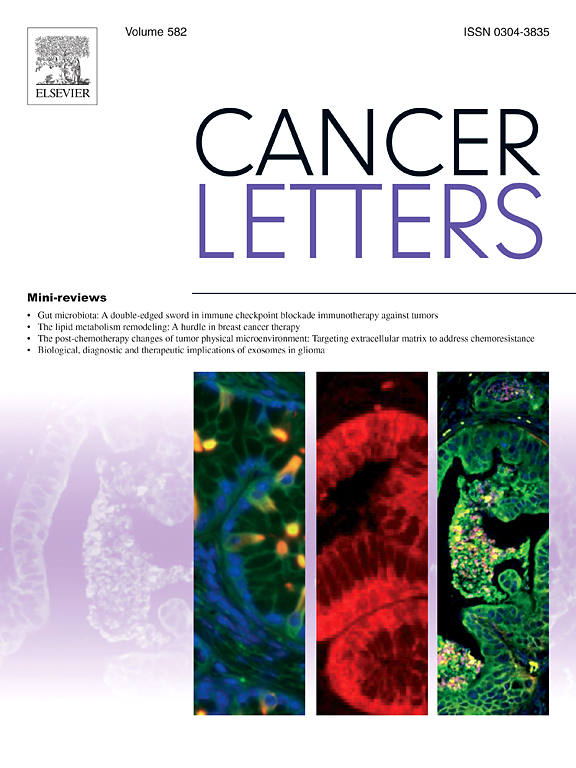clns1a介导的非小细胞肺癌化疗耐药和肿瘤进展的机制见解
IF 9.1
1区 医学
Q1 ONCOLOGY
引用次数: 0
摘要
CLNS1A是一种氯离子通道蛋白,是甲基体复合体的重要组成部分,该复合体还包括PRMT5和MEP50。在这项研究中,我们研究了它在肺癌中的作用及其作为治疗靶点的潜力。转录组学数据集和western blotting分析显示,CLNS1A、PRMT5和MEP50在肺癌组织中过表达,CLNS1A表达升高与患者生存率低相关。CLNS1A过表达增强了细胞对铂的清除率,增加了化疗的IC50值,并改善了细胞存活率。相反,CLNS1A基因的敲低增加了药物积累,降低了生存率,增加了对化疗的敏感性。3W突变体是一种氯离子通道缺陷突变体,在关键瓶颈残基处存在位阻,破坏氯离子运输,从而降低耐药性、迁移和不依赖锚定的生长。机制上,CLNS1A通过其氯离子通道活性促进药物外排,激活FAK-SRC-RAC1通路,增强运动性和致克隆性。它还促进prmt5介导的RUVBL1甲基化,以支持抗凋亡DNA损伤反应信号传导。在体内,CLNS1A过表达加速肿瘤生长,降低生存期,而CLNS1A敲低使肿瘤对顺铂敏感,提高治疗效果。这些发现表明,CLNS1A是一种潜在的生物标志物和治疗靶点,其抑制提供了一种克服耐药和限制肺癌转移进展的策略。本文章由计算机程序翻译,如有差异,请以英文原文为准。
Mechanistic insights into CLNS1A-mediated chemoresistance and tumor progression in non-small cell lung cancer
CLNS1A is a chloride channel protein and an essential component of the methylosome complex, which additionally comprises PRMT5 and MEP50. In this study, we investigated its contribution to lung cancer and its potential as a therapeutic target. Analysis of transcriptomic datasets and western blotting revealed that CLNS1A, PRMT5, and MEP50 were overexpressed in lung cancer tissues, with elevated CLNS1A expression correlating with poor patient survival. CLNS1A overexpression enhanced platinum clearance from cells, increased the IC50 values for chemotherapy, and improved cell survival. Conversely, the knockdown of CLNS1A increased drug accumulation, reduced survival, and increased sensitivity to chemotherapy. The 3W mutant, a chloride channel-defective variant with steric hindrance at key bottleneck residues, impaired chloride ion transport, thereby reducing drug resistance, migration, and anchorage-independent growth. Mechanistically, CLNS1A promotes drug efflux through its chloride channel activity and activates the FAK-SRC-RAC1 pathway to enhance motility and clonogenicity. It also facilitates PRMT5-mediated RUVBL1 methylation to support anti-apoptotic DNA damage response signaling. In vivo, CLNS1A overexpression accelerated tumor growth and reduced survival, whereas CLNS1A knockdown sensitized tumors to cisplatin, enhancing therapeutic efficacy. These findings suggest that CLNS1A is a potential biomarker and therapeutic target, and its inhibition offers a strategy to overcome drug resistance and limit the metastatic progression of lung cancer.
求助全文
通过发布文献求助,成功后即可免费获取论文全文。
去求助
来源期刊

Cancer letters
医学-肿瘤学
CiteScore
17.70
自引率
2.10%
发文量
427
审稿时长
15 days
期刊介绍:
Cancer Letters is a reputable international journal that serves as a platform for significant and original contributions in cancer research. The journal welcomes both full-length articles and Mini Reviews in the wide-ranging field of basic and translational oncology. Furthermore, it frequently presents Special Issues that shed light on current and topical areas in cancer research.
Cancer Letters is highly interested in various fundamental aspects that can cater to a diverse readership. These areas include the molecular genetics and cell biology of cancer, radiation biology, molecular pathology, hormones and cancer, viral oncology, metastasis, and chemoprevention. The journal actively focuses on experimental therapeutics, particularly the advancement of targeted therapies for personalized cancer medicine, such as metronomic chemotherapy.
By publishing groundbreaking research and promoting advancements in cancer treatments, Cancer Letters aims to actively contribute to the fight against cancer and the improvement of patient outcomes.
 求助内容:
求助内容: 应助结果提醒方式:
应助结果提醒方式:


